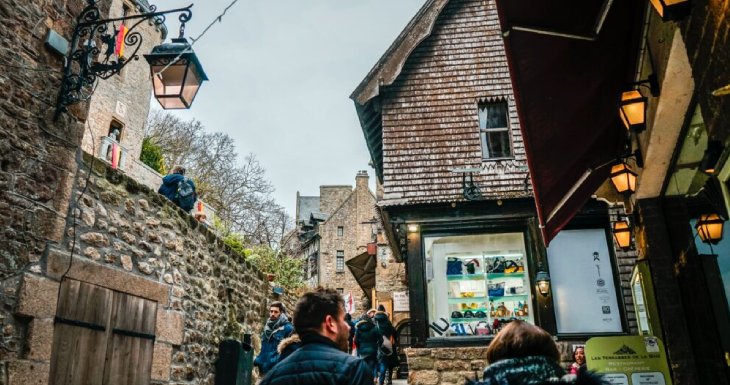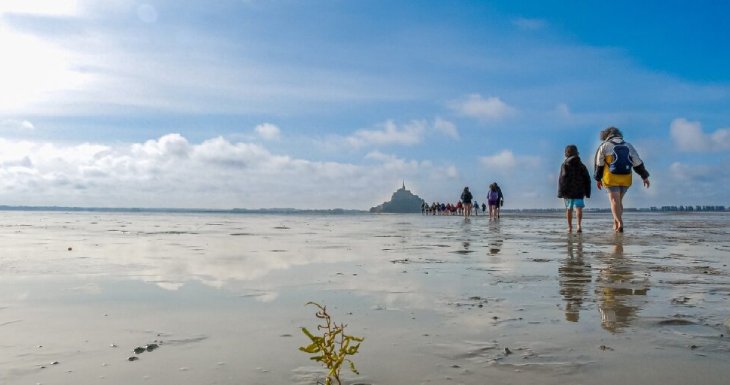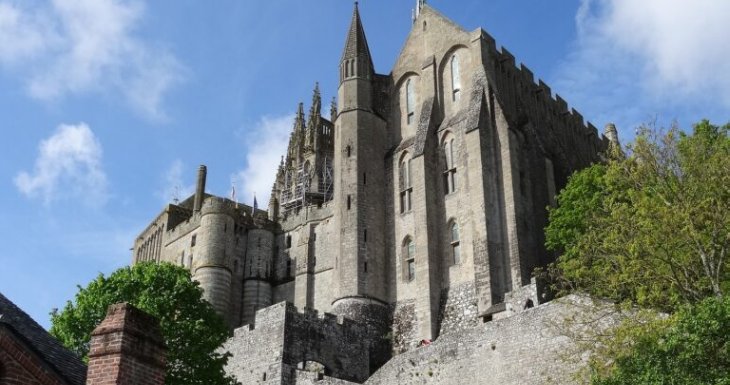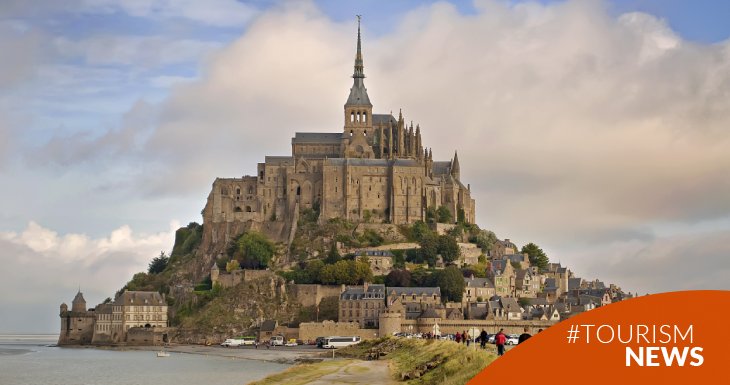A cascade of walls and buttresses descending from a towering central spire, the medieval Mont Saint-Michel Abbey is a spectacular creation that has played a crucial role in French history over the centuries. It is located on some rocks that emerge from the sea, where the waters of the Atlantic converge with the mouth of the Couesnon River, off the Normandy coast, west of Paris. It has a circumference of 960 meters and only about 4 square kilometers, and it attracts 1.3 million tourists a year.
Due to its proximity to Paris, Mont Saint-Michel can be accessed by car via the A13 and A11 motorways; or by bus - leaving from La Défense terminal - in about 4 hours. On some occasions, when the tide is very high, the road is flooded and cannot be accessed until it goes down again. Check the tide times on the official Mont Saint-Michel website for up-to-date information.
Another alternative is to travel by train from the Paris Montparnasse station, from where direct trains leave, to Pontorson, which is the closest train station. There are also direct flights that depart from the Charles de Gaulle airport in Paris, to the Rennes - Brittany airport and where flights from other cities with stopovers also arrive.
A jewel of architecture that celebrates 1,000 years
The architecture of Mont Saint-Michel encompasses various styles, since the construction took place over several centuries.
Legend says that Saint Michael Archangel appeared in a priest's dream and indicated the place to build a worship palce. That point is the islet where the abbey is located. It became a sacred place that continued to evolve from the 11th to the 16th century. Currently, the abbey is inhabited by 12 monks who live off what each one knows, as honey production and handmade souvenirs for tourists.
This year marks a millennium since its construction began and to celebrate, the Mont is hosting concerts, conferences and an exhibition on its history and architecture, from June to November 2023.
The abbey has witnessed key moments in French history, most notably becoming a fortress during the Hundred Years' War of the 14th and 15th centuries and surviving a 30-year siege by the British. It was a prison during the French Revolution of the 18th century. In 1863, 14,000 prisoners spent time in the "Bastille of the Seas," where the tides and shifting sands made escape impossible.

During the Belle Époque, prior to World War I, the monument gradually developed into the global tourist attraction we know today. One of its most popular landmarks is the famous inn de la Mère Poulard - the place where the famous Mont Saint-Michel omelette was invented - named after its founder, the brilliant cook Annette Poulard, and which has been welcoming visitors since 1888.
What is the best time of the year to visit it:
It depends on personal preferences and what you want to experience during the visit:
- Summer (June to August): it is the high season in Mont Saint-Michel. During these months, the weather is usually warm and there are many daylight hours. However, it is also the busiest period, which means that there will be more tourists and you may find long lines at the attractions.
- Spring (March to May) and Autumn (September to November): they are considered "shoulder" periods in Mont Saint-Michel. The weather is milder and there are less crowds compared to summer. You will be able to enjoy blooming landscapes in spring and fall colors in fall.
- Winter (December to February): This is the low season in Mont Saint-Michel. The weather can be cold and wet, with possible rain and strong winds.
Whether you choose spring with its blooming flowers, fall with its warm colors, or even winter with its quiet serenity, each season has its own special allure.

Enjoy a memorable visit to this impressive work of nature and man:
At the entrance to Mont Saint-Michel, you'll find a tide clock that shows how the tides change throughout the day. It is impressive to see how the island is surrounded by water during high tides that reach 14 meters. Before, this site was only accessible when the tide was low or by boat when it was high, until in 2014 they built a walkway from the mainland that also restored its essence as an island.
The 8th century Benedictine Abbey is the most important site on the island. You can tour its cloisters, rooms and gardens, and appreciate the panoramic views of the sea and the surroundings from the terraces.

In the Grand Rue, the main street, you will feel like you are in a fairytale place with its little cafes, gift shops and buildings dating from the 15th and 16th centuries. And its narrow, cobbled streets give it a medieval charm you won't find anywhere else.
For the adventurous - and weather permitting - taking the guided walking tour of the Mont Saint-Michel bay is a unique experience to understand the natural beauty of the area. La Chapelle-Saint-Aubert, is a hidden gem on the island. It is a small stone chapel with beautiful paintings inside and a charming altar. Legend says that it all began in that chapel, since it was there that Bishop Avranches was touched by the Michael Archangel.
And if you are interested in history, do not hesitate to visit the Mont Saint-Michel historical museum, with historical pieces, sculptures, weapons, instruments of torture and paintings, dating from the year 1300 to the present.
Its imposing architectural beauty, its rich history and its majestic location in the middle of the sea make it an unforgettable destination: Mont Saint-Michel captivates in every way.


